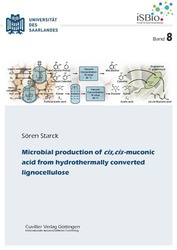| Departments | |
|---|---|
| Book Series (96) |
1378
|
| Nachhaltigkeit |
3
|
| Gesundheitswesen |
1
|
| Humanities |
2364
|
| Natural Sciences |
5406
|
| Mathematics | 229 |
| Informatics | 319 |
| Physics | 980 |
| Chemistry | 1363 |
| Geosciences | 131 |
| Human medicine | 243 |
| Stomatology | 10 |
| Veterinary medicine | 108 |
| Pharmacy | 147 |
| Biology | 835 |
| Biochemistry, molecular biology, gene technology | 121 |
| Biophysics | 25 |
| Domestic and nutritional science | 45 |
| Agricultural science | 1004 |
| Forest science | 201 |
| Horticultural science | 20 |
| Environmental research, ecology and landscape conservation | 148 |
| Engineering |
1791
|
| Common |
98
|
|
Leitlinien Unfallchirurgie
5. Auflage bestellen |
|
Advanced Search
Microbial production of cis,cis-muconic acid from hydrothermally converted lignocellulose (Volume 8) (English shop)
Sören Starck (Author)Preview
Extract, PDF (380 KB)
Table of Contents, PDF (140 KB)
Cis,cis-muconic acid receives increasing interest to be produced from renewables. Catabolic microbial pathways can be tailored to accumulate cis,cis-muconic acid from a range of aromatic compounds. A renewable, sustainable and under-valued resource for aromatics is lignin. In this work, using hydrothermal conversion, lignin was depolymerized into hydrolysates with up to 615 mM aromatic monomer content. Catechol-rich hydrolysates were generated for bioconversion with the previously developed cis,cis-muconic acid producers P. putida MA-9 and C. glutamicum MA-2, whereas hydrolysates were guaiacol-rich for Amycolatopsis sp. MA-2. When grown with glucose as a co-substrate, C. glutamicum MA-2 yielded 2.6 g L⁻¹ (100 % yield) cis,cis-muconic acid from catechol. Towards an even more sustainable process, glucose was then replaced by hemicellulose, a non-food renewable. Hemicellulose, a co-constituent of lignin in lignocellulose, was hydrothermally converted into a mixture of C₅ and C₆ sugars. As hemicellulose was mainly converted into xylose (91 % yield), C. glutamicum MA-2 was engineered to utilize this pentose. Fed-batch bioconversion on a catechol-rich Kraft lignin hydrolysate as well as a hemicellulose hydrolysate using C. glutamicum MA-4 yielded 4 g L⁻¹ muconic acids. As the developed process was non-competitive to feed and food, it is a promising starting point for future application in bio-based industrial settings.
| ISBN-13 (Hard Copy) | 9783736975897 |
| ISBN-13 (eBook) | 9783736965898 |
| Final Book Format | A5 |
| Language | English |
| Page Number | 134 |
| Lamination of Cover | matt |
| Edition | 1. |
| Book Series | Hochschulschriften - Institut für Systembiotechnologie, Universität des Saarlandes |
| Volume | 8 |
| Publication Place | Göttingen |
| Place of Dissertation | Saarbrücken |
| Publication Date | 2022-03-17 |
| General Categorization | Dissertation |
| Departments |
Biology
Microbiology and biotechnology Mechanical and process engineering Allgemeine Verfahrenstechnik |
| Keywords | Lignin, Hemicellulose, Lignocellulose, Hydrothermal Conversion, Muconic acid, Adipic acid, Nylon, Pseudomonas putida, Corynebacterium glutamicum, Amycolatopsis, renewable, sustainable, fermentation, aromatics, bio-based ecomomy, catechol, guaiacol, xylose, metabolic engineering, biomass, distillation, Kraft process, activated charcoal, dioxygenase, fed-batch, HPLC, GC-MS, bioconversion, Hemicellulose, cis-Mukonsäure, renewable resources, nachwachsende Rohstoffe, Lignintypen, Mukonsäureproduzenten, mikrobielle Stoffwechselwege, muconic acid producers, microbial pathways, Aromate, aromatics, Nahrungsindustrie, bio-basierte Industrie, bio-based industry, fossile Ressourcen, fossil resources, Monomerausbeute, Biokonversion, Depolymerisierungsstrategie, depolymerization strategy, metabolisches Engineering, microbial factory, metabolic engineering, Produktanreicherung, product accumulation, Valorisierung, valorization, verschiedene Holzarten, different wood species, Fraktionierungsmethoden, Depolymerisationsstrategie, depolymerization strategy, lignozellulosehaltige Biomasse, hydrothermale Umwandlung, hydrothermal conversion, chemische Industrie, chemical industry, Bioraffinerien, biorefineries, Nahrungspflanzen, Non-Food-Materialien, non-food materials, food crops, Vanillinmarkt, Nebenproduktstrom, low value side-stream |
| URL to External Homepage | https://www.isbio.de/ |








